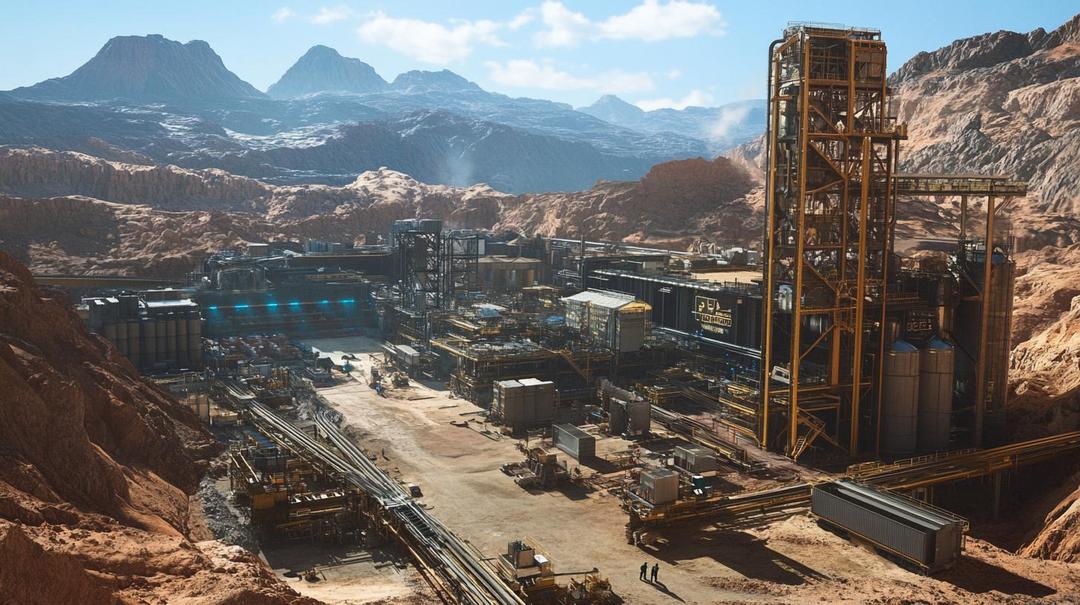The U.S. depends heavily on imports for rare earth materials—a supply chain vulnerability that has caught the attention of policymakers, engineers, and investors. Here’s a shocking fact: in 2021, the U.S. accounted for less than 2% of global rare earth processing! (Yes, you read that right). But things are changing—fast.
We’ll unravel the state of rare earth processing facilities in America, their significance to industries like renewable energy and tech, and the opportunities for building a stronger domestic supply chain.
Let’s dig in!
What's Inside
What Are Rare Earth Processing Facilities in America, and Why Are They Important?
Rare earth processing facilities are specialized industrial sites that transform raw rare earth elements (REEs) into usable materials critical for modern technology. These facilities follow a complex journey from mining to final manufacturing, involving multiple sophisticated stages of separation, refinement, and processing.
The importance of these facilities to America cannot be overstated. The United States currently relies heavily on imports, particularly from China, for rare earth elements that are essential to national defense, renewable energy, electronics, and electric vehicle production. This dependency creates significant economic and geopolitical vulnerabilities that domestic processing could help mitigate.
Current State of Rare Earth Processing Facilities in America (2025)
U.S. Production Landscape
As of 2025, the United States has made modest but meaningful progress in rare earth processing capabilities. While not yet a global leader, the country has begun developing strategic facilities that aim to reduce international dependencies.
Key Processing Locations
Several notable facilities have emerged across the country. Mountain Pass in California stands out as the only fully operational rare earth mining and processing site. Texas Rare Earth Resources has also developed significant processing infrastructure, signaling a growing commitment to domestic rare earth production.
Production Capacity
Modern facilities are actively scaling up to meet increasing industrial demands. The focus is on developing efficient, technologically advanced processing methods that can compete with international competitors, particularly those in China and Australia.
Challenges Facing Rare Earth Processing Facilities in America
Economic barriers remain significant. Processing rare earth elements is expensive, with high refinement costs that make domestic production challenging compared to international markets. Technical complexities further complicate these efforts, as separating and refining raw materials requires specialized expertise and cutting-edge technologies.
Environmental regulations in the United States also present unique challenges. Stricter waste management and mining impact guidelines make domestic processing more complicated and costly than in countries with less rigorous environmental standards.
Geopolitical Considerations
The rare earth processing landscape is heavily influenced by international competition. The United States must navigate complex trade relationships and potential restrictions while attempting to establish a robust domestic processing infrastructure.
Opportunities: Strengthening America’s Rare Earth Processing Infrastructure
Technological innovation offers promising solutions. Researchers are developing more cost-efficient and environmentally friendly processing methods, leveraging artificial intelligence, automation, and advanced manufacturing techniques.
Government support has become increasingly crucial. Initiatives like the Defense Production Act and Bipartisan Infrastructure Law provide critical funding and policy frameworks to support domestic rare earth processing development.
Strategic Partnerships
Collaborations between public and private sectors are emerging as key strategies. Partnerships with allied nations like Australia and Japan help secure raw material supply chains and share technological advancements.
Case Studies: Emerging Rare Earth Processing Facilities in the U.S.
Mountain Pass Facility
Located in California, the Mountain Pass facility represents a significant milestone in domestic rare earth processing. Operated by MP Materials, it is currently the only fully operational rare earth mining and processing site in the United States.
Innovative Regional Developments
Other promising developments include the Lynas-U.S. collaboration in Texas, jointly funded by the Department of Defense, and Energy Fuels’ White Mesa Mill in Utah, which is exploring innovative methods of rare earth refinement.
Environmental and Geopolitical Impacts of Rare Earth Processing
Environmental considerations remain paramount. Processing facilities must carefully manage potential risks of water and soil contamination, developing robust mitigation strategies that align with sustainable practices.
The geopolitical dimension is equally complex. Strengthening domestic processing capabilities represents a strategic approach to reducing dependence on foreign suppliers, particularly in the context of U.S.-China technological and economic competition.
The long-term vision extends beyond immediate economic benefits. By developing sustainable rare earth processing infrastructure, the United States can play a crucial role in supporting the global transition to renewable energy technologies.
Conclusion
Rare earth processing facilities in America are emerging as a cornerstone of the nation’s push for economic independence and technological competitiveness. While challenges like cost and environmental concerns persist, advances in technology, strong governmental support, and rising industry demand create a path forward for the U.S. to reclaim a larger share of the global rare earth market.
Whether you’re an investor looking for your next big opportunity or an environmentalist tracking the industry’s impact, the message is clear: the rare earth revolution is underway, and America plans to lead from the front. Stay tuned, and make sure you’re part of this transformation!
FAQs
What are rare earth elements used for?
Rare earth elements are critical for producing magnets, batteries, electronics, wind turbines, electric vehicles, and military hardware like radar systems.
Where is the largest rare earth processing facility in the U.S.?
The largest operational facility is the Mountain Pass mine in California, managed by MP Materials.
Why is the U.S. expanding rare earth processing facilities?
To reduce dependence on imports, secure supply chains for key industries, and compete with countries like China in the rare earth sector.
Are rare earths harmful to process?
Processing rare earth elements can generate harmful waste byproducts, such as radioactive materials. However, advanced methods are being developed to mitigate these impacts.
What role does the government play in rare earth processing?
The U.S. government provides grants, tax incentives, and funding programs like the Defense Production Act to support domestic rare earth processing and manufacturing.


Dustin
Driven by a fascination with rare earth elements and their role in powering modern tech and engineering marvels. A true car and tech enthusiast, he loves exploring how these hidden heroes fuel our most exciting innovations.
You Might Also Like…